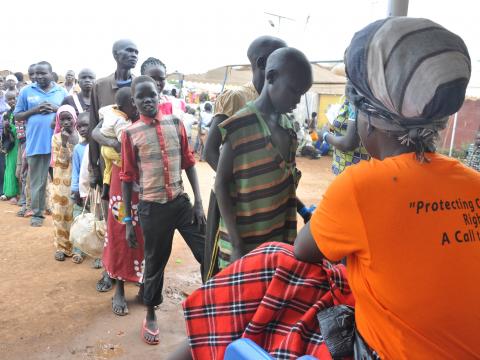World Vision Uganda responds to latest South Sudanese refugee influx

Background
On the 7th of July 2016, Uganda began receiving unusual numbers of refugees from South Sudan, ranging between 1060-4940 persons per day. This as fighting in South Sudan’s capital Juba resumed.
The recent fighting in Africa’s youngest nation has now seen more than 38,491 South Sudanese refugees move into Uganda in just 4 weeks. In context, the number of refugees Uganda has received in the last four weeks is much higher than the total number of refugees it has received in the past 7 months, standing at 38,836 people.
Uganda is now host to more than 300,000 South Sudanese refugees in the Northern part of the country, all receiving food assistance from World Vision.
The influx has greatly strained the capacity of collection points, transit and reception centers in Uganda, pushing the government to open two new settlement camps in Pagarinya, Adjumani district.
These two new settlements have however also been overwhelmed and now government has resolved to open up another refugee settlement in Yumbe district, which is going to be housing more than 100,000 people.
What has been done for the refugees?
The new caseload of refugees has already begun receiving plots of land inside the newly gazetted refugee settlement at pagarinya.
Each refugee is getting a 30x30 meters plot of land to establish a home. It is upon getting a plot of land that the refugees qualify to receive monthly food rations from World Vision. Otherwise they are only entitled to hot meals.
World Vision begun distributing food to the new lot at Maaji 3 settlement and was able to reach out to 13,410 refugees with sorghum, beans, mix CSB+, vegetable oil and salt. Distribution is still on for other settlements.
World vision is also distributing food at all transit centres; Nyumanzi and Pagarinya in Adjumani.
What is World Vision Uganda doing?
1.World Vision is the lead agency doing general food distribution in partnership with WFP, reaching out to more than 145000 refugees with food assistance.
2.World vision is distributing High-energy biscuits to all new refugees at the boarder.
3.World Vision is implementing a protection program, which entails 4 child friendly spaces ; early child hood development and peace building.
4.WV has been doing WASH; renovating water sources, constructing bore halls and latrines, plus establishing water user committees.
5.WV is in addition to food distribution, also going to be in charge of delivering non-food items and preparing hot meals at the new refugee settlement in Yumbe
What are the major challenges on ground?
-Delays in receiving hot meals at the reception centers in the settlement camps. This is due to the ever-increasing numbers of refugees, which keeps increasing almost every hour.
-Shelter is a big challenge. Several refugees are sleeping in open spaces, as the few semi-permanent structures constructed by UNHCR are full to capacity.
-WASH, especially lack of latrines in the new camp is a major worry. The rainy season has begun and the lack of latrines could easily lead to a cholera out break
-Lack of NFI’s like basins, cloths and other house hold items for the new arrivals
-Child protection is still an issue as the new settlement in Pagarinya has only one child friendly space run by Save the Children. World Vision is yet to establish two new child friendly spaces

